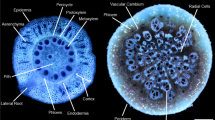Abstract
Tillers and seedlings ofHordeum jubatum L. from three sites with contrasting salinity regimes in central Saskatchewan, Canada were reciprocally transplanted in order to examine the tolerance of populations of this species to salinity and related habitat factors. Survival, growth and fecundity of the three populations were controlled more by transplant site characteristics than by genetic differences, i.e. differences among populations at a site tended to be smaller than differences among sites. Survival, growth and reproduction of all three populations were best at the non-saline site. The population originating at the non-saline site showed the poorest growth in the two saline habitats, but still had substantial salt tolerance. Fecundity was greatest when the populations were grow at their site of origin.
Similar content being viewed by others
References
Ab-Shukor, N. A., Kay, Q. O. N., Stevens, D. P. & Skibinski, D. O. F. 1988. Salt tolerance in natural populations ofTrifolium repens L. New Phytol. 109: 483–490.
Ashraf, M., McNeilly, T. & Bradshaw, A. D. 1989. The potential for evolution of tolerance to sodium chloride, calcium chloride, magnesium chloride and seawater in four grass species. New Phytol. 112: 245–254.
Badger, K. S. & Ungar, I. A. 1990. Seedling competition and the distribution ofHordeum jubatum L. along a soil salinity gradient. Func. Ecol. 4: 639–644.
Best, K. F., Banting, J. D. & Bowes, G. G. 1978. The biology of Canadian weeds. 31.Hordeum jubatum L. Can. J. Plant Sci. 58: 699–708.
Bowman, W. D. 1988. Ionic and water relations responses of two populations of a non-halophyte to salinity. J. Exp. Bot. 39: 97–105.
Bradshaw, A. D. 1985. Ecological significance of genetic variation between populations, pp. 213–228. In: Dirzo, R. & Saruknan, J. (eds.) Perspectives on Plant Population Ecology. Sinauer, Sunderland, MA.
Cavers, P. B. & Harper, J. L. 1967. Studies in the dynamics of plant populations. I. The fate of seed and transplants introduced in various habitats. J. Ecol. 55: 59–71.
Davy, A. J. & Smith, H. 1985. Population differentiation in the life-history characteristics of salt-marsh annuals. Vegetatio 61: 117–125.
Dodd, J. D. & Coupland, R. T. 1966. Vegetation of saline areas in Saskatchewan. Ecology 47: 958–968.
Hannon, N. J. & Bradshaw, A. D. 1968. Evolution of salt tolerance in two existing species of grass. Nature 220: 1342–1343.
Jain, S. K. 1976. The evolution of inbreeding in plants. Annu. Rev. Ecol. Syst. 7: 469–495.
Janzen, H. H. & Chang, C. 1987. Cation nutrition of barley as influenced by soil solution composition in a saline soil. Can. J. Soil Sci. 67: 619–629.
Kik, C. 1989 Ecological genetics of salt resistance in a clonal perennial,Agrostis stolonifera L. New Phytol. 113: 453–458.
Lee, H. S., Zangerl, A. R., Garbutt, K. & Bazzaz, F. A. 1986. within and between species variation in response to environmental gradients inPolygonum pennsylvanicum andPolygonum virginianum. Oecologia (Berl.) 68: 606–610.
Partridge, T. R. & Wilson, J. B. 1988. The use of field transplants in determining environmental tolerance in salt marshes of Otago, New Zealand. N. Z. J. Bot. 26: 183–192.
Peterson, R. G. 1985. Design and Analysis of Experiments. Marcel Dekker, Inc., New York, Basel.
Seliskar, D. M. 1985. Effect of reciprocal transplanting between extremes of plant zones on morphometric plasticity of five plant species in an Oregon salt marsh. Can. J. Bot. 63: 2254–2262.
Shumaker, K. M. & Babble, G. R. 1980. Patterns of allozymic similarity in ecologically central and marginal populations ofHordeum jubatum in Utah. Evolution 34: 110–116.
Snaydon, R. W. & Davies, M. S. 1976 Rapid population differentiation in a mosaic environment. IV. Population ofAnthoxanthum odoratum at sharp boundaries. Heredity 37: 9–25.
Steel, R. G. D. & Torrie, J. H. 1980. Principles and Procedures of Statistics: A Biometrical Approach. Second edition. McGraw-Hill, New York, USA.
suhayda, C. G., Redmann, R. E., Harvey, B. L. & Cipywnyk, A. L. 1992. Comparative response of cultivated and wild barley species to salinity stress and calcium supply. Crop Sci. 32: 154–163.
Thompson, J. D., McNeilly, T. & Gray, A. J. 1991a. Population variation inSpartina anglica C. E. Hubbard. I. Evidence from a common garden experiment. New Phytol. 117: 115–128.
Thompson, J. D., McNeilly, T. & Gray, A. J. 1991b. Population variation inSpartina anglica C. E. Hubbard. II. Reciprocal transplants among three successional populations. New Phytol. 117: 129–139.
Tiku, B. L. & Snaydon, R. W. 1971. Salinity tolerance within grass speciesAgrostis stolonifera L. Plant and Soil 35: 421–431.
Venables, A. V. & Wilkins, D. A. 1978. Salt tolerance in pasture grasses. New Phytol. 80: 613–622.
Wilson, D. B. 1967. Growth ofHordeum jubatum under various soil conditions and degrees of plant competition. Can. J. Plant Sci. 47: 405–412.
Wu, L. 1981. The potential for evolution of salinity tolerance inAgrostis stolonifera L. andAgrostis tenuis Sibth. New Phytol. 89: 471–486.
Wang, X. Y., Suhayda, C. G. & Redmann, R. E. 1992. Identification of physiological ecotypes inHordeum jubatum based on responses to salinity stress. Can. J. Bot. 70: 1123–1130.
Author information
Authors and Affiliations
Rights and permissions
About this article
Cite this article
Wang, X.Y., Redmann, R.E. Adaptation to salinity inHordeum jubatum L. populations studied using reciprocal transplants. Vegetatio 123, 65–71 (1996). https://doi.org/10.1007/BF00044888
Received:
Accepted:
Issue Date:
DOI: https://doi.org/10.1007/BF00044888




